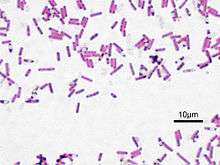Bacilli
| Bacillus | |
|---|---|
 | |
| Bacillus subtilis, Gram staine | |
| Scientific classification | |
| Domain: | Bacteria |
| Phylum: | Firmicutes |
| Class: | Bacilli Ludwig et al. 2010 |
| Orders | |
Bacilli refers to a taxonomic class of bacteria. It includes two orders, Bacillales and Lactobacillales, which contain several well-known pathogens such as Bacillus anthracis (the cause of anthrax). All Bacilli are gram-positive bacteria.[1]
Ambiguity
Several related concepts make use of similar words, and the ambiguity can create considerable confusion. The term "Bacillus" (capitalized and italicized) is also the name of a genus(Bacillus anthracis) that, among many other genera, falls within the class Bacilli.
Also, "bacillus" (or the plural "bacilli") can be a generic term to describe the morphology of any rod-shaped bacterium. This general term does not mean that the subject is a member of class Bacilli or genus Bacillus. Thus, it does not necessarily imply a similar group of characteristics. Not all members of class Bacilli are rod-shaped (Staphylococcus is spherical), and many other rod-shaped bacteria that do not fall within that class (Clostridium kamina dalla kotta is rod-shaped but very different taxonomically) exist. Moreover, the general term "bacillus" does not necessarily indicate the Gram-positive staining common to class Bacilli. For example, E. coli is a rod-shaped bacterium that could, therefore, be described as "a bacillus", but it stains Gram-negative and does not belong to genus Bacillus or class Bacilli. Some microbiologists have forsaken the general "bacillus" term because of the confusion it can create.
Phylogeny
The currently accepted taxonomy is based on the List of Prokaryotic names with Standing in Nomenclature:[2] [3] and the phylogeny is based on 16S rRNA-based LTP release 106 by 'The All-Species Living Tree' Project [4]
| Bacilli |
| ||||||||||||||||||||||||||||||||||||||||||||||||||||||||||||||||||||||||||||||||||||||||||||||||||||||||||||||||||
| |
Unclassified Bacillales
- Alkalilactibacillus ♠ Schmidt et al. 2007
- Alkalilactibacillus ikkense ♠ Schmidt et al. 2007
- Dehalobacterium ♠ Magli et al. 1996
- Dehalobacterium formicoaceticum ♠ Magli et al. 1996
- Pseudobacillus ♠ Gomez 1999
- Pseudobacillus carolinae ♠ Gomez 1999
- Trigonala ♠ Zhang et al. 2006
- Trigonala elaeagnus ♠ Zhang et al. 2006
Notes:
♠ Strains found at the National Center for Biotechnology Information (NCBI) but not listed in the List of Prokaryotic names with Standing in Nomenclature LPSN
Bacilli part 2 (continued)
| Bacilli part 2 |
| ||||||||||||||||||||||||||||||||||||||||||||||||||||||||||||||||||||||||||||||||||||||||||||||||||||||||||||||||||||||||||||||||||||||||||||||||||||||||||||
| |
References
- ↑ Ludwig, Wolfgang; Schleifer, Karl-Heinz; Whitman, William B. (2015). "Bacilli class. Nov". Bergey's Manual of Systematics of Archaea and Bacteria. p. 1. doi:10.1002/9781118960608.cbm00033. ISBN 9781118960608.
- ↑ See the List of Prokaryotic names with Standing in Nomenclature. Data extracted from J.P. Euzéby. "Bacilli". Retrieved 2012-05-17.
- ↑ See the NCBI webpage on Bacilli Data extracted from Sayers; et al. "NCBI Taxonomy Browser". National Center for Biotechnology Information. Retrieved 2012-05-17.
- ↑ See the 'The All-Species Living Tree' Project . Data extracted from the "16S rRNA-based LTP release 106 (full tree)" (PDF). Silva Comprehensive Ribosomal RNA Database. Retrieved 2012-05-17.